 
(Botticino marble in the Monument to Victor Emmanuel,
Brickwork in S. Maria in Aracoeli and Travertine in Palazzo Nuovo) |
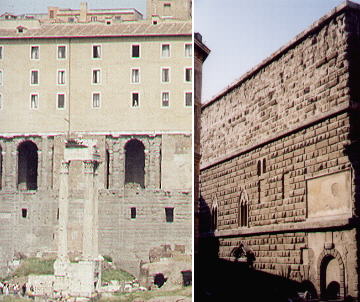 | Tufa supporting Palazzo Senatorio and a peperino wall in the Forum of Nerva. Tufa is a grey/yellow porous rock of volcanic origin. It is widely available in many locations around Rome. It was the first building material used by the Romans. The Republican (Servian) Walls were built by using large tufa blocks. Peperino is a green/brown volcanic rock formed of small grains of cinders and sand. Its minute pepper like black spots are at the origin of its name. Unlike tufa, peperino can be cut and polished in order to obtain some decorative effects. It was widely used (in small blocks) in the aqueducts near Porta Furba and in Ponte di Nona. |
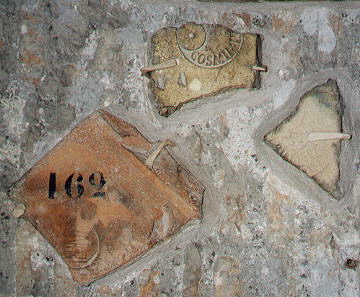 | Fragments of bricks showing their trade-marks in the portico of
S. Saba. The Romans made wide use of brickwork in a variety of techniques (opus latericium) which help in identifying the period during which a certain building was erected. Archaeologists are also helped by the trade-marks stamped on the bricks by the manufacturers: they had different shapes and they often indicated the name of the manufacturer. The Pantheon, Terme di Caracalla, Basilica di Massenzio are among the most imposing examples of brickwork usage. The Romans used bricks for columns and other decorations in many tombs in Via Latina and in Via Appia Antica. |
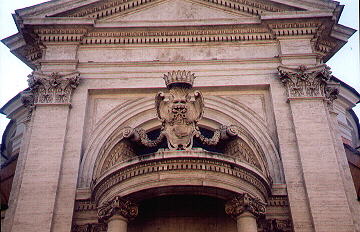 | Travertine fašade of S. Andrea al Quirinale. Travertine is a yellowish limestone formed by the precipitation of calcium carbonate. It was found in large quantities near Ponte Lucano, where there are still several quarries in operation. No doubt travertine is the stone of Rome. The Colosseum and Bernini's St. Peter's Colonnade are the best known examples of travertine monuments. Most of the Renaissance and Baroque churches were clad in and decorated with travertine. Bernini used it also for sculptures (Fontana del Tritone). |
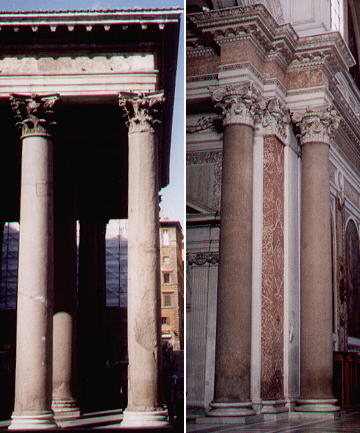 | Red granite columns in the Pantheon and in S. Maria degli Angeli. Granite is a very hard igneous rock made up of feldspar, mica and quartz. The particles of quartz give it some shining effects. The granite used in Rome was either grey or pink. Pink granite was used by the Egyptians for their obelisks. The imposing columns shown in the images to the left are monoliths. In designing S. Maria degli Angeli, Michelangelo used eight existing red granite columns to decorate the main nave. In the XVIIIth century the basilica was given a new orientation by Luigi Vanvitelli, who added eight fake granite columns. In the image the column to the right is original, the column to the left is made of painted brick. By touching the columns one realizes which is which: the granite column is always cooler than the fake one. |
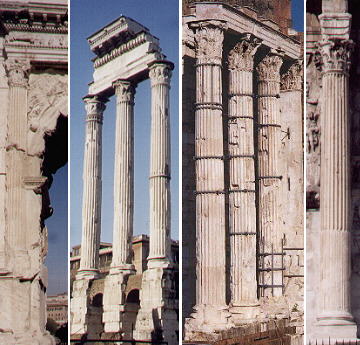 | White marbles: Pentelic marble (the marble of the Parthenon) in Arco di Tito; Marble from Paros (Greek island) in Tempio di Castore e Polluce; Lunense marble (Carrara marble) in Foro di Augusto; Marble from Numidia (Morocco) in Arco di Costantino. The Romans initially relied on the marbles used by the Greeks, but they found in the mountains near the town of Luni (today Carrara) a source of white marble which could compete with the Greek marbles. Piramide di Caio Cestio was the first Roman monument covered with Lunense. Quarries in Numidia provided the Romans with a variety of yellow marbles ranging from nearly white to ochre. |
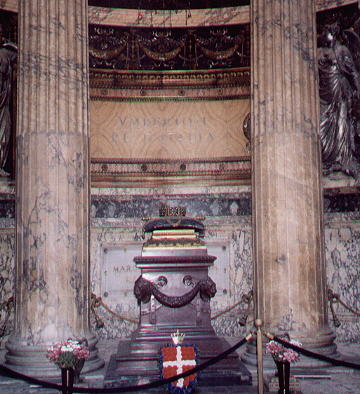 | Pavonazzetto columns in the Pantheon. In the IInd century A.D. during the Age of the Antonines (Trajan, Hadrian, Antoninus Pius, Marcus Aurelius) coloured marbles prevailed on the traditional white marbles. In the Pantheon, almost entirely rebuilt by Hadrian, the seven niches, where the statues of the gods were worshipped, were decorated with two gigantic columns of Numidian yellow marble or of pavonazzetto, a breccia coming from Phrygia (today Turkey). Breccia is a rock consisting of fragments of stone such as marble or limestones within a natural cement of a contrasting colour. The veins of pavonazzetto had so many different colours that brought to mind peacock feathers hence this stone's name (pavone=peacock). Raphael was buried in the Pantheon and in the XIXth century its niches became the burial chapels of the Kings of Italy (the image shows the Monument to Umberto I). |
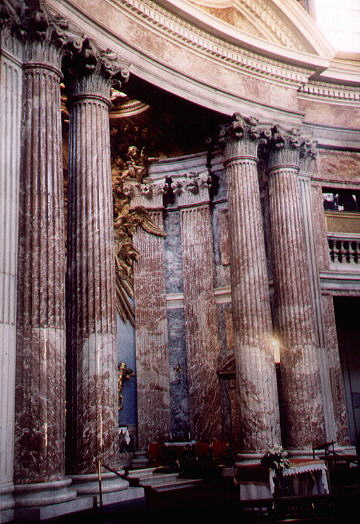 | Cottanello columns in S. Andrea al Quirinale. The columns in the Pantheon responded to an architectural objective: they maintained the rounded shape of the central hall, reducing the dispersive effect of the niches with the statues of the gods. When Bernini designed S. Andrea al Quirinale, he was confronted with a similar problem. The church had an elliptical shape, but the liturgical need for a main chapel dedicated to St. Andrew, threatened to weaken the impact of the ellipse. Bernini adopted the solution given to the same problem in the Pantheon 1500 years before. Four gigantic columns of cottanello separate the main chapel from the elliptical hall. S. Andrea al Quirinale is the last architectural work by Bernini and at that time there were no longer columns of ancient buildings which could be utilized for this purpose, so Bernini used cottanello, not properly a marble, but a marl limestone found in a quarry near a village by the same name in Sabina. The columns were cut after a long study of the ore in order to obtain the best possible effect. While in most Baroque churches the preferred contrasting colours were red and green, Bernini chose subdued colours combining the pink cottanello columns with grigio antico (ancient grey) walls. 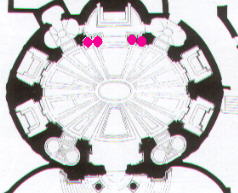 |
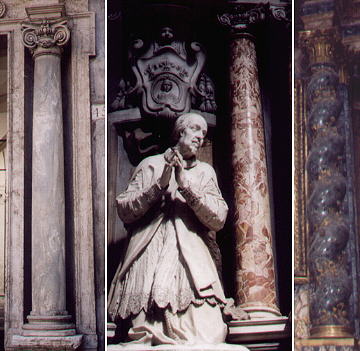 | Coloured marbles: Cipollino column in Immacolata Concezione in Campo Marzio; Diaspro column in Ges¨ e Maria; Verde antico column in S. Ignazio. Cipollino is a marble with green and white streaks from Karistos in Greece. Hadrian in particular liked this marble. Imposing cipollino columns can be seen in S. Lorenzo in Miranda (and in Hadrian's Library in Athens). Diaspro is a crystalline silicate of sea origin. Its Sicilian variety (diaspro fiorito) was widely used in the XVIIth century to clad columns and walls. Verde (Giallo/Bigio) Antico (ancient (yellow/grey) green) is the generic term used in the XVIIth century to indicate the coloured marbles recovered from the ancient buildings and mainly used in the decoration of chapels. |
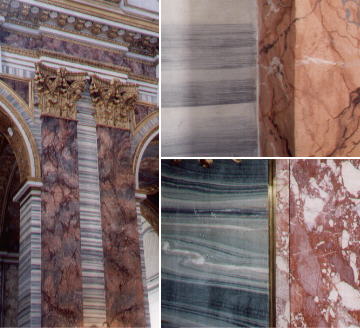 | Fake (main nave) and true (chapels) marbles in S. Carlo al Corso. In the second half of the XVIIIth century and chiefly in the XIXth century the lack of resources put a severe limit to the use of marble. So in some churches the initial impression of a lavish decoration turns out to be wrong when one gets closer to it. |
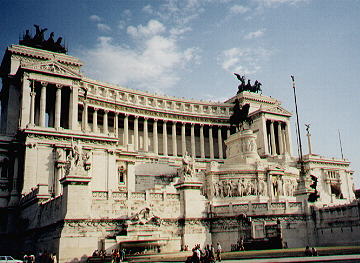 | Botticino marble in Monument to Victor Emmanuel. The gigantic Monument to Victor Emmanuel was the major addition to Rome during the Kingdom of Italy (1861-1945). Apparently the decision to use botticino, a white marble from the town by the same name near Brescia in northern Italy, was made by the then Prime Minister Giuseppe Zanardelli who was born in Brescia. Botticino is a marble of excellent quality, but its whiteness does not match the slightly yellowish colour of the main monuments of Rome. |
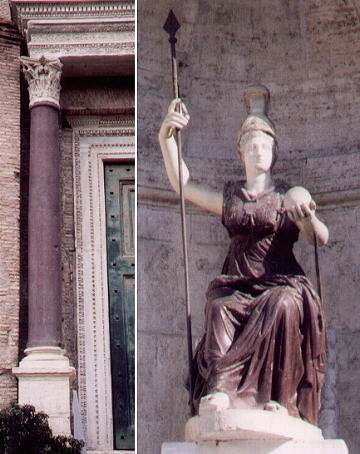 | Porphyry column in Temple of Romulus and statue of Rome in Piazza del Campidoglio. Porphyry is a hard igneous rock of which the most famous type is deep red. Because of its similarity to purple, which was the colour symbolizing authority, red porphyry was called Imperial porphyry. It came from Egypt and it was highly prized by the ancient Romans. In the IVth century Costanza, daughter of the emperor Constantine the Great, was buried in a beautiful porphyry sarcophagus in S. Costanza. In the XII/XIIIth centuries many ancient porphyry columns were sliced to obtain discs to decorate the pavements of churches (Cosmati mosaics). Fine Cosmati pavements can be seen in S. Giovanni in Laterano, S. Maria Maggiore, S. Maria in Cosmedin and S. Grisogono. |
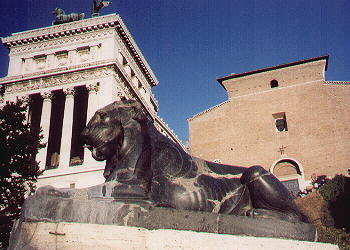 | Basalt lion in Piazza del Campidoglio. Basalt is a dark and hard igneous rock used for sculpture by the ancient Egyptians. In Rome basalt is limited to Egyptian statues. A basaltic lava was used by the Romans for paving their roads. |
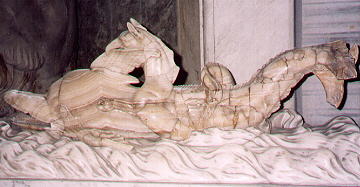 | Small alabaster statue by Francesco Franzoni in the Vatican Museums. Alabaster is a soft and easily carved limestone used for sculpture which is not exposed to the elements. Because of its translucency it sometimes replaced glass in the windows of chapels in order to obtain a diffused light. Six huge alabaster columns were presented by Mohammed Ali as a contribution of Egypt to the reconstruction of S. Paolo fuori le Mura. |
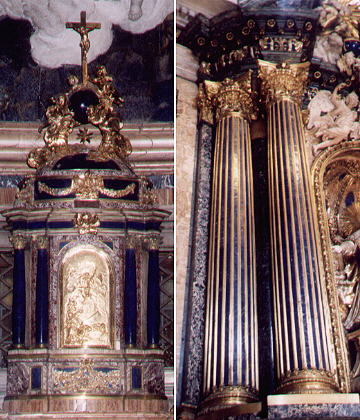 | Lapis lazuli ciborium in S. Caterina da Siena a Magnanapoli and
lapis lazuli columns in il Ges¨. Lapis lazuli is a semi-precious blue silicate, most often used in association with gold in small objects. Because of its scarceness the lapis lazuli coated columns of the altar-tomb of St. Ignatius in il Ges¨, were considered the unsurpassable limit of luxury and sumptuousness. |
 or to
The Coats of Arms of the Popes or
to My Home Page on Baroque Rome or to
My Home Page on Rome in the footsteps of an XVIIIth century traveller
or to
The Coats of Arms of the Popes or
to My Home Page on Baroque Rome or to
My Home Page on Rome in the footsteps of an XVIIIth century traveller
All images © 1999 - 2003 by Roberto Piperno. Write to romapip@quipo.it
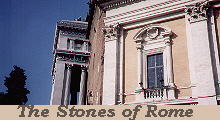 The Stones of Rome
The Stones of Rome